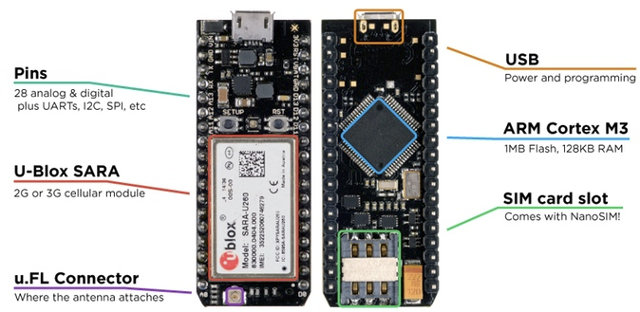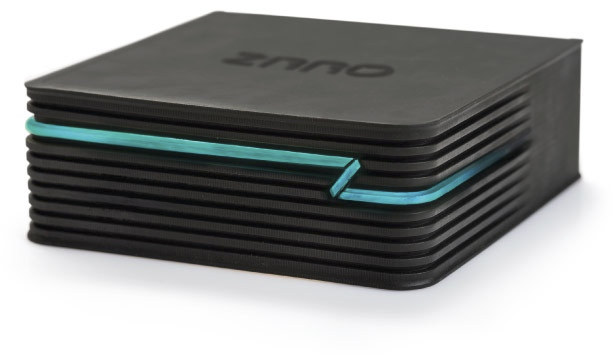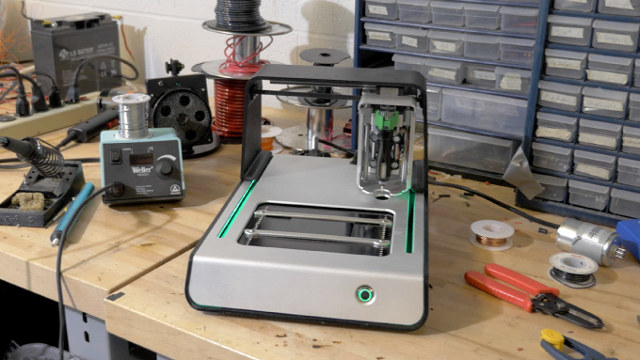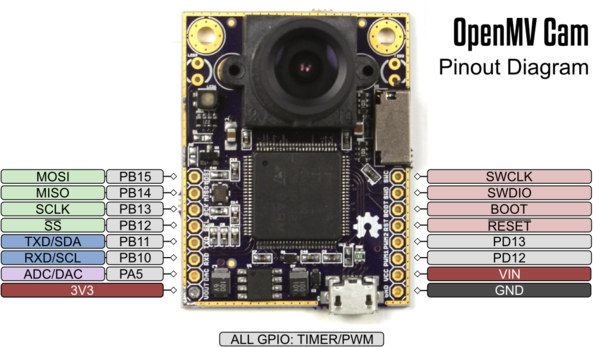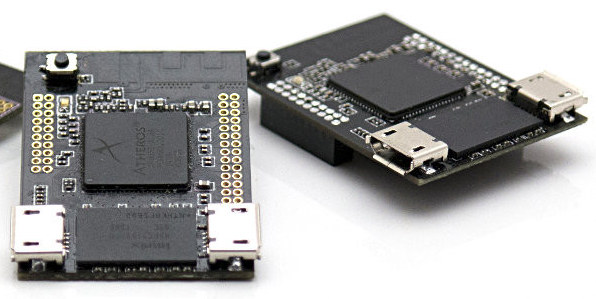Spark IO started with Spark Core, a tiny Wi-Fi module, followed with Spark Photon is a cheaper, faster, and tinier Wi-Fi module, and now the company is launching Spark Electron to bring cellular connectivity to hobbyist projects at an affordable cost and small form factor. Spark Electron specifications: MCU – ST Micro STM32F205 ARM Cortex M3 microcontroller @ 120 MHz with 1MB Flash, 128K RAM Cellular Connectivity – U-Blox SARA U-series (3G) or G-series (2G) modem + NanoSIM card slot + u.FL connector for Antenna Headers – 36 pins with 28 GPIOs (D0-D13, A0-A13), plus TX/RX, 2 GNDs, VIN, VBAT, WKP, 3V3, RST USB – micro USB port for power and programming Misc – Setup and reset buttons, LED Dimensions – 5.08 cm x 2.03 cm x 0.76 cm (1.27 cm including headers) The board can be programmed with Wiring (Arduino’s programming language), C/C++, or ARM assembly. It’s longer than Spark […]
GroBotz Interactive Robot Project is Made of Easy to Assemble Smart Blocks (Crowdfunding)
GroBotz makes me think of Lego applied to robotics. The project consists of modules such as motors, sensors, buttons, switches, or cameras that snap together in order to create a robot on wheels, games, toys, a musical instrument, or whatever idea you may have, and the hardware is then programmed using a graphical user interface. A Raspberry Pi board is used for the brain of the robot, and Microchip PIC MCUs for the smart blocks. The software is programmed in C# using Xamarin, the user interface is based on Unity, OpenCV is used for image processing, and during development a plastic part where printed with Makerbot, and schematics and PCB layout designed with CadSoft EAGLE. The company has now come up with a number of modules as shown in the picture below. Your robot can then be controlled over Wi-Fi with GroBotz app which works on Windows, Mac OS, iOs, […]
Pebble Time is the Color Version of the Pebble SmartWatch (Crowdfunding)
The original Pebble Watch launched on Kickstarter about 3 years ago, and after selling over 1 million watches, the company is back on Kickstarter with Pebble Time, a thinner version of the watch with an always-on color e-Paper display, a new “timeline” user interface, a microphone for voice recognition, and 7 days of battery life. The complete Pebble Time specifications are not available, but the company still listed some key features: MCU – Cortex M4 Always-on, daylight readable 64 colors e-Paper display with backlight (no touchscreen) Six-axis gyrosope Microphone for dictation 3x tactile buttons Bluetooth for connectivity with mobile devices Up to 7 day battery life Compatible with any standard 22mm watch band Water resistant and durable Silent vibrating alarms Language and international character support (Chinese coming soon) The new Timeline interface focuses on past, present and future events such as basketball score, current steps, and weather forecast, and the […]
Beam Android Projector Fits into Any Light Socket (Crowdfunding)
Four years ago, Seco showcased a prototype of a light bulb integrating a picoprojector and running Android, so you could fit it on the socket on your ceiling or compatible lamp. Now a company is planning to launch an Android projector that fits into E27, E26, or Bayonet light sockets called Beam. Beam projector specifications: SoC – Dual core processor @ 1.3GHz System Memory – N/A (1GB?) Storage – 8GB storage Projector LED pico projector; Currently 854×480 resolution, but it may be upgraded before the product ships ANSI 100 lumens 20,000 projection hours Max projection size – 120″ widescreen Throw ratop – 1.6:1 meaning at 1.8m, the project size will be 1.1m. Lamp function: 12 LED lights Audio – 2W stereo speakers Connectivity – 802.11 b/g/n Wi-Fi, Bluetooth 4.0 Light socket – E26, E27, or Bayonet via included adapter Power Supply – 110VAC to 240VAC Dimensions – N/A The version […]
ZRRO Android Game Console Includes a Hover and Touch Controller (Crowdfunding)
Android games are fun to play… on smartphones and tablets, but if you want to play such games on a TV screen via an Android mini PC, it can become more problematic, as most of the games were designed for touchscreen, so you have to be prepare to juggle between input devices.. In my reviews, I have to play Candy Crush Saga with an air mouse, and I switch to a wireless gamepad for racing games such as Riptide GP2 or Beach Buggy Racing, while some games are simply not playable at all without touch emulation, unless you install a software remote such as Droidmote on your smartphone, and use the latter as a controller, which may not be ideal either. ZRRO, an Israeli company, came with a new package comprised of an Android game console (ZRRO Box), and a game controller (ZRRO Pad) featuring a hover and touch surface […]
Voltera V-One is a Low Cost PCB Printer and Solder Paste Dispenser (Crowdfunding)
The traditional hardware development cycle involve sending PCB Gerber files to a manufacturer, wait a few days (or weeks), get the boards back, find and fix bugs, send a new revision of the gerber files to the manufacturer and so on. This wastes a lot of time, so PCB printers capable of handline single and dual layer PCBs have started to see the light of the day, for example with BotFactory Squink. The latter can also do pick and place, but costs over $3,500. Luckily if you’d like something cheaper, Voltera V-One will do many of the same tasks, for but for only $1,500. Voltera V-One specifications: Minimum Trace Width – 8mil (~0.2mm) Minimum Passive Size – 0603 (0402 for solder paste) Minimum Pin-to-Pin Pitch – 0.8mm (0.5mm for solder paste) Resistance – >12 mOhm/sq @ 70um height Max Heated Bed Temperature – 250C Heated Bed Ramp Rate – ~2C/s […]
OpenMV is an Open Source Hardware VGA Camera Controllable with Python Scripts (Crowdfunding)
Recently I’ve seen some activity about tiny cameras for makers, including Linux based SinoVoIP BPI-D1 recording up to 720p30 videos, and an upcoming mini camera for VoCore Wi-Fi module. There’s now another project called OpenMV, and open source camera for machine vision applications based on STMicro STM32, recording up to VGA resolution at 20 fps, and controlled using Micro Python scripts. OpemMV camera specifications: MCU – STM32F427, 180MHz, 225 DMIPS, 256K SRAM, 2M Flash, DMA/FPU/DSP/DCMI/SDIO/2D Acceleration Camera – 2MP OV2640 sensor with interchangeable M12 lens, 2x IR LEDS Storage – uSD interface: SDIO (4-bit mode) Expansions – 2x headers with USART, SPI, I2C, PWM, ADC/DAC, GPIOs, PWM and power signals USB – micro USB 2.0 Full Speed port Power Supply – 5V via USB; Current draw is approximately 140mA, steady state Dimensions – 4.57 x 3.56 cm The camera can be controlled using (Micro) Python scripts. with the project’s OpenMV […]
Black Swift is a Tiny OpenWRT Wi-Fi Board Powered by Atheros AR9331 (Crowdfunding)
In case you thought there were not enough Wi-Fi board in the market already, here’s another one with Black Swift. The board runs OpenWRT, is a little larger than Vocore, and quite smaller than WRTnode, is powered by Atheros AR9331, provides access to I/Os via headers, and comes with two micro USB ports which should make it easy to use, and allow some interesting applications with USB devices. Black Swift specifications: SoC – Qualcomm Atheros AR9331 32-bit MIPS 24K CPU core @ 400 MHz, or 200 MHz in energy-saving mode selectable by software System Memory – 64 MB DDR2 SDRAM Storage – 16 MB NOR flash Connectivity – 802.11 b/g/n Wi-Fi (1×1, up to 150 Mbps) with PCB antenna USB – 1 x microUSB for power, 1x microUSB 2.0 port Expansion – Headers for 26x GPIO, 2x Fast Ethernet, SPI, I²C, 1x 16550 UART, 1x USB 2.0 Misc – Factory reset […]


